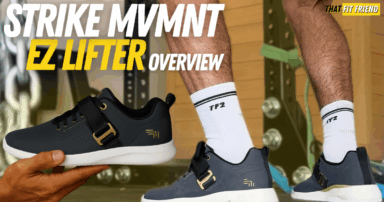I don’t know about you but I have a love-hate relationship with split squats. Whether It’s a regular split squat, front foot elevated (FFE) split squat, or rear foot elevated (RFE) split squat, all are equally great and brutal.
One of the best parts about split squats is how dynamic they can be. This article is for anyone who’s wondered about the differences between a regular split squat versus a rear foot elevated split squat versus a front foot elevated split squat.
I regularly rotate all of these split squat variations in my own training and my client’s programs based on training goals. I’ll discuss the benefits of each and the “why” behind using each below.
If you’re new to split squats, perform the regular variation to nail the form. The rear foot elevated split squat is a little more advanced and can be great for targeting the quads. The front foot elevated split squat can be a good variation for a glute and hip focus.
Split Squat Comparison Programming Considerations
Author’s Note: The rear foot elevated split squat is often referred to as a Bulgarian split squat. These two exercises are essentially the same thing and I opt for calling them “rear foot elevated split squats” because it’s a more descriptive name.
Split Squat Vs Rear Foot Elevated Vs Front Foot Elevated
When considering using split squats, rear foot elevated split squats, and front foot elevated split squats in your training program you’ll want to consider a few things before simply throwing them into a workout.
Coaching Note: There are countless reasons behind “why” coaches will program and use these variations, and the below is not intended to be an “end all be all” on the topic. The following is how I like to use these variations for my coaching and programming.
Which Is Better for Beginners?
For beginners just starting their lifting journey the normal split squat will generally be the best variation to start with. This exercise will give you a little “more” regarding your base of support and it requires less to set up.
On top of this, it can be easier to dial in your form with a normal split squat and adjust your stance and means of executing reps accordingly. Since both feet are in contact with the ground it can be easier to make mid-set adjustments as you get more reps in.
The normal split squat can also be great for beginners that want to focus on improving their balance, strength, and lower body hypertrophy. There are endless ways to modify a normal split squat.
For example, you can change tempo, add pauses, tweak your stance, and manipulate how you’re loading split squats to progress without changing the exercise variation you’re performing.
Which Is Better for Quads?
If your goal is building your quads with split squats, then all of these split squat variations can be great options to explore depending on things like your training age, needs, and anatomical needs.
In general, though, the rear foot elevated split squat will typically be the best option for pure quad-focused goals. With this variation, you get a lot of loading on the front leg and typically work through a large degree of knee flexion which will put more stress on the quads.
Additionally, you’ll get to a greater degree of hip extension and knee flexion faster with the back leg when using rear-foot elevated split squats which can be great for training quad muscles like the rectus femoris through a lengthened position.
The normal split squat can also be great for the quads, especially for beginners who are just starting to focus on unilateral leg strength and hypertrophy. In fact, beginners can go a long way using and perfecting their split squats for quad growth before shifting to rear-foot elevated variations.
The front foot elevated split squat can be useful for building the quads when you’re a taller lifter or a lifter with lagging hip mobility. With the front foot elevated, you’ll hit hip extension on the back leg at a slower rate which can “feel” better for lifters in these contexts and allow them to focus on their front leg more.
Bonus Tip: For more quad in all of these variations, explore using weightlifting shoes or wedges. A heel-elevated setup will put your knees into an environment that can feed better into forward knee translation (knees coming over the toes) which can be great for lengthening the quads and putting more stress on them.
Which Is Better for Glutes?
The front-foot elevated split squat and rear-foot elevated split squat can be great variations for the glutes. Note, this is not to say the regular split squat isn’t because it can be great for the glutes, too.
However, I’ll typically opt for the front-foot elevated and rear-foot elevated split squat for the glutes for a few reasons. If my goal is biasing the glutes and avoiding a ton of quad focus and fatigue, then I’ll opt for the front-foot elevated split squat.
By elevating the front foot to different degrees and not letting the knee track forward as heavily on the front leg you can get a nice glute focus without overloading the quads of the front leg. This is great for programs that already have a lot of quad work programmed.
If the goal is hammering the legs in general while challenging the glutes from a strength and stability context, then I’ll opt for the rear-foot elevated split squat. This variation can be great for hitting the glutes and your rear foot elevation can factor into this.
Typically, I’ll lean forward a little more when performing rear-foot elevated split squats when I want more glute. This slight forward lean will lengthen the glute max a little more and challenge the glute through a greater range of motion.
Bonus Tip: In general, if you limit how much the knees are tracking over the toes and instead focus on using a slightly forward torso position, you can get a little more glute in all of these split squat variations.
Which Is Better for Athletes?
If you’re an athlete wanting to build their lower body strength, then you can benefit from all of these split squats variations, and the “best” variation will be dependent on your training goals and sports schedule.
The normal split squat will be great for athletes that want an exercise that delivers a lot of benefits without too much of a skill focus to it. Split squats will be great for athletes from all walks of life and sports at different skill levels.
The rear foot elevated split squat can be great for athletes who are a little more advanced in their training age. In addition, I like using rear-foot elevated split squats for athletes like hockey players who generally have good balance and need more focus on opening the back hip.
The front-foot elevated split squat can be useful for athletes who want to train their legs without putting a ton of stress on their front leg and hips. These are awesome for athletes who typically feel “beat up” after their sport but want to build their unilateral capacity and capabilities still. They can also be great for athletes with limited lower-body mobility.
Frequently Asked Questions (FAQ)
Q:Are elevated split squats better?
Q:Why elevate back foot for split squat?
Q:Are rear foot elevated split squats the same as Bulgarian split squats?
Q:What is the most effective split squat?
Takeaway Thoughts
The split squat versus rear-foot elevated split squat versus front-foot elevated split squat is a fun topic to discuss and explore. All of these variations can be great depending on your training goals and needs.
The split squat is great for pretty much all lifters and athletes, the rear-foot elevated split squat is great for loading the front leg to a greater degree, and the front-foot elevated split squat is great for focusing on the glutes and taking some weight off the front leg.
If you have additional questions about these split squat variations and when to use each, drop a comment below or reach out to me personally via Instagram (@jake_boly or @that_fit_friend).

















Add a Comment